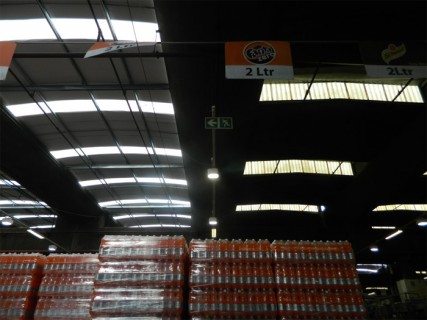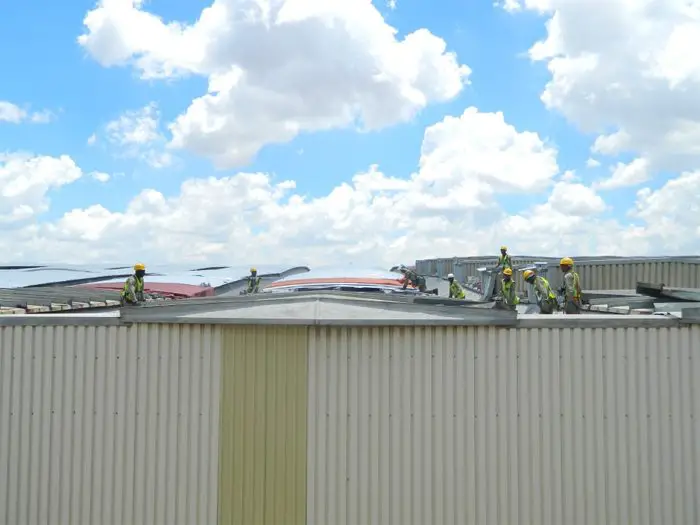New roofing system will vastly improve in-plant lighting and ergonomics.
When the time came for Amalgamated Beverage Industries (ABI) to refurbish the roof of its bottling plant in Devland, it looked for a business that has earned a reputation in the industry for its expertise in dealing with unusual roof designs.
Since the ABI plant had been built using a very specific ‘origami style’ roof, a contractor with both this specific proficiency and an extensive track record in the commercial and industrial maintenance sector was required. Based on previous experiences with the organisation, ABI turned to R&D Contracting to solve its roofing challenges.
The ABI bottling plant in Devland is a world-class manufacturing site, which has been producing cool drinks for the South African market for decades. However, as with any older facility, the plant’s roof was reaching the end of its natural lifespan, having become victim to corrosion, caused by the harsh vagaries of South African weather. The engineers who originally built it adopted an ‘origami style’ for the roof, which utilises very specifically folded steel that is designed to be self-supporting.
When it came time to replace the roof, says David Williams, Managing Member and Technical Sales Director at R&D Contracting, retaining the origami style was not cost-effective, as although it is self-supporting, it utilises large volumes of steel. “Instead, we decided to base the design of the new roof on a previous project we had completed for ABI at its Wadeville Coca Cola canning plant,” he says.
Williams explains that the project currently sees R&D removing around six tons of steel from the roof every week. This is being replaced by a far lighter zinc aluminium composite – known as zinc alum – that is just 0.55mm thick. He states that on average, the company is installing between 12 and 18 metres of the new roofing per day.
The galvanised support beams are specially designed for the project, and are certified by engineers, prior to implementation, he adds. Williams also points out that R&D is using sisalation underneath the zinc alum roofing for the purposes of insulation. This is also far thinner than the previous insulation used, but thanks to a reflective coating on the outside, is just as effective at keeping the factory cool.
“The sisalation is a key innovation here, as it improves vastly on the old roof, which utilised sponge, fitted between double steel, for insulation purposes. Sponge works fine in a new roof, but as the roof ages, it becomes easier for this sponge to get wet. I can tell you that vast tracts of wet sponge add an enormous additional weight load onto the roof. Fortunately, this is all negated now by the far lighter zinc alum roofing and the sisaltion we are using instead.”
Williams explains that the project is expected to take approximately 10 months from site set-up to conclusion. This, he adds, does not include theadditional time required for preparation and fabrication prior to starting.
The preparation included ensuring that the zinc alum roof sheets were rolled to the correct size, that the supporting beams were properly prepared and certified, and that everything was delivered to the site on schedule.
“In addition, there were aspects like health checks and safety lectures for the workers, ensuring that all the necessary tools are available on site and making sure that the site manager has access to an office with Internet connectivity, so he can stay in touch with the head office, so any potential challenges can quickly be dealt with.”
“Another feature of this project is that R&D is focused on improving skills. This means that we will bring in three or four new employees to gain experience here, over the course of the entire project. By allowing them to learn on the job, they are able to gain valuable experience that will stand them in good stead as they continue their career,” says Williams.
This high level of preparation is vital, continues Williams, because ABI needed the plant to remain fully functional during the re-roofing project. The nature of the plant is such that it would not be cost effective to ABI to shut it down for any extended period, which is yet another reason why the company turned to R&D in the first place – the company has a reputation for being able to undertake projects like this without impacting on the work done within the facility.
He points out that the intense preparation beforehand has so far meant that the project has remained on track and, when the new roof is fully installed, it will be both safer and more ergonomically friendly than the one it has replaced, meaning it should provide effective protection from the elements for several decades at least.
Johny Kruger, Site Manager at ABI Devland, points out that the ergonomics of the new roof can be found in how effectively it improves the natural light coming into the plant.
“The old roof had been designed with raised segments, which in turn had glass fibre sheeting on the sides. This was supposed to allow light in, but it is very old technology and was probably not really ideal even when it was implemented – let alone when one considers how little light was coming in after decades of weathering,” he says.

Kruger indicates that in order to increase the natural light coming in, R&D utilised polycarbonate sheeting to allow sunlight into the building. He says that one in every five roofing sheets was made of this polycarbonate material, which diffuses the light and ensures that there are no bright pinpoints of light at certain times of the day. These, after all, can be blinding and thus create a safety hazard.
“We are utilising a colour known as Opal White, which offered the best diffusion of light when we tested different colour sheets. Even though only 20% of the roof is composed of these sheets, we expect it to increase the amount of available light entering the building from under 400 lux to upwards of 1300 lux.”
This, continues Kruger, not only improves working conditions within the plant, but also reduces ABI’s electricity costs. In fact, he says, R&D estimates that within a decade years, the electricity savings alone will enable ABI to recoup the cost of the entire roofing project.
“Safety laws around lighting inside a plant of this nature are quite strict and as I understand it, the minimum lux that is acceptable is around 500 lux. With the new roof, the plant achieves over 1 000 lux, even on cloudy days – and this is from natural light alone, it doesn’t take into account the electrical lighting that is also present.”

The other important benefit of this sheeting is that it improves the ergonomics within the plant as well. For example, says Kruger, better lighting helps to keep employees more awake and thus less likely to make errors; it reduces eye strain; and it generally improves the working conditions for employees. This has additional tangible benefits, since happier employees are more productive employees.

“In addition, we will also be installing extractor fans in the roof, which will help to remove fumes from the from the exhausts of the ever-present forklifts. This will also help to improve the general wellbeing of employees in the plant and the overall working environment,” states Kruger.
According to Williams, the company has approximately 15 staff on site at any given time, which makes the issue of safety, health and environment (SHE) a critical one.
“SHE is very important to R&D and ABI, and is a vital component of a project of this nature. Quite aside from the obviously crucial safety measures taken while working on the roof itself, we also take the health and welfare of employees a step further. There are regular medical check-ups scheduled for all our employees. These focus specifically on hearing-, eyesight- and respiratory-related matters,
He adds that after each employee has undergone their first medical check-up, this is used as a baseline against which all subsequent tests can be measured and compared, in order to check for deviations from the norm.
“As for our employees on site at ABI, the company also takes it upon itself to conduct regular ‘toolbox talks’ with employees. These meetings revolve around site-specific SHE issues and involve basic explanations of what to do and what not to do,” says Williams.
Furthermore, he indicates that R&D also conducts a site-specific risk assessment every week at the facility. Workers operating on the roof are also fitted with redundant safety lines – in fact everything up there is double secured – to ensure that risk is minimised, both for R&D’s workers and the ABI employees inside the plant.
“It is particularly important from an ABI perspective to know that its plant can continue functioning normally and ensure that the integrity of its bottling lines is not compromised, even as R&D goes about replacing the roofing. To this end, safety nets that can hold up to 400kg per square metre are placed underneath the working environment.
These provide additional protection for our staff – should they accidentally slip and fall – and also added protection for employees in the factory from any accidents occurring that involve large items of equipment. This net is an additional safety measure, above and beyond the double-securing that is undertaken on all our equipment.”
“It is always satisfying to be involved in a project of this nature. Not only are we able to radically improve ergonomic conditions within the plant, we are able to bring our technical skills and expertise to bear in a way that will provide ABI with a new roof that will withstand the elements for decades to come. Furthermore, a project like this enables R&D to further hone both its skills set and its development of better roofing techniques. At the end of the day, R&D Contracting is a solutions-oriented company and we are always eager to find new and better ways to do things,” concludes Williams.
